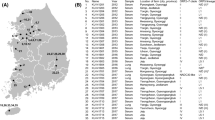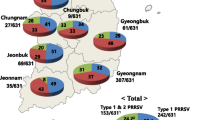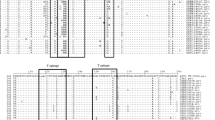Abstract
Porcine reproductive and respiratory syndrome virus (PRRSV) is the most important pathogen in the Korean swine industry. Despite efforts including improved biosecurity and vaccination protocols, the virus continues to circulate and evolve. Based on phylogenetic analysis of open reading frame 5 (ORF5), Korean PRRSVs are known to form not only globally circulating lineages but also country-specific lineages (Lin Kor A, B, and C). To understand the recent epidemiological status of PRRSV in Korea, a total of 1349 ORF5 sequences of Korean PRRSV isolates from 2014 to 2019 were analyzed. Phylogenetic analysis was conducted using the maximum-likelihood method, and temporal changes in the relative prevalence of lineages were investigated. The analysis showed that PRRSV1 and PRRSV2 were both highly prevalent throughout the years examined. Among the PRRSV1 isolates, subgroup A (90.1%) and vaccine-like subgroup C (9.0%) composed most of the population. For PRRSV2 isolates, vaccine-like lineage 5 (36.3%) was dominant, followed by Lin Kor B (25.9%), Kor C (16.6%), lineage 1 (11.6%), and Kor A (9.1%). The PRRSV2 lineage 1 population increased from 2014 (1.8%) to 2019 (29.6%) in Korea due to the continual spread of sublineage 1.8 (NADC30-like) and introduction of sublineage 1.6 into the country. Additional genetic analysis, including analysis of non synonymous and synonymous mutations, revealed evidence of diversification and positive selection in immunologically important regions of the genome, suggesting that current vaccination is failing and promoting immune-mediated selection. Overall, these findings provide insights into the epidemiological and evolutionary dynamics of cocirculating viral lineages, and constant surveillance of PRRSV occurrence is needed.





Similar content being viewed by others
References
Alkhamis MA, Perez AM, Murtaugh MP, Wang X, Morrison RB (2016) Applications of Bayesian phylodynamic methods in a recent US porcine reproductive and respiratory syndrome virus outbreak. Front Microbiol 7:67
Ansari IH, Kwon B, Osorio FA, Pattnaik AK (2006) Influence of N-linked glycosylation of porcine reproductive and respiratory syndrome virus GP5 on virus infectivity, antigenicity, and ability to induce neutralizing antibodies. J Virol 80:3994–4004
Argimón S, Abudahab K, Goater RJ, Fedosejev A, Bhai J, Glasner C, Feil EJ, Holden MT, Yeats CA, Grundmann H (2016) Microreact: visualizing and sharing data for genomic epidemiology and phylogeography. Microb Genom. https://doi.org/10.1099/mgen.0.000093
Cha S-H, Choi E-J, Park J-H, Yoon S-R, Song J-Y, Kwon J-H, Song H-J, Yoon K-J (2006) Molecular characterization of recent Korean porcine reproductive and respiratory syndrome (PRRS) viruses and comparison to other Asian PRRS viruses. Vet Microbiol 117:248–257
Chen N, Liu Q, Qiao M, Deng X, Chen X, Sun M (2017) Whole genome characterization of a novel porcine reproductive and respiratory syndrome virus 1 isolate: genetic evidence for recombination between Amervac vaccine and circulating strains in mainland China. Infect Genet Evol 54:308–313
Crooks GE, Hon G, Chandonia J-M, Brenner SE (2004) WebLogo: a sequence logo generator. Genome Res 14:1188–1190
Delisle B, Gagnon CA, Lambert M-È, D’Allaire S (2012) Porcine reproductive and respiratory syndrome virus diversity of Eastern Canada swine herds in a large sequence dataset reveals two hypervariable regions under positive selection. Infect Genet Evol 12:1111–1119
Díaz I, Pujols J, Ganges L, Gimeno M, Darwich L, Domingo M, Mateu E (2009) In silico prediction and ex vivo evaluation of potential T-cell epitopes in glycoproteins 4 and 5 and nucleocapsid protein of genotype-I (European) of porcine reproductive and respiratory syndrome virus. Vaccine 27:5603–5611
Díaz I, Gimeno M, Darwich L, Navarro N, Kuzemtseva L, López S, Galindo I, Segalés J, Martín M, Pujols J (2012) Characterization of homologous and heterologous adaptive immune responses in porcine reproductive and respiratory syndrome virus infection. Vet Res 43:1–15
Eclercy J, Renson P, Lebret A, Hirchaud E, Normand V, Andraud M, Paboeuf F, Blanchard Y, Rose N, Bourry O (2019) A field recombinant strain derived from two type 1 porcine reproductive and respiratory syndrome virus (PRRSV-1) modified live vaccines shows increased viremia and transmission in SPF pigs. Viruses 11:296
Geldhof MF, Vanhee M, Van Breedam W, Van Doorsselaere J, Karniychuk UU, Nauwynck HJ (2012) Comparison of the efficacy of autogenous inactivated Porcine Reproductive and Respiratory Syndrome Virus (PRRSV) vaccines with that of commercial vaccines against homologous and heterologous challenges. BMC Vet Res 8:1–16
Guo Z, Chen X-x, Li R, Qiao S, Zhang G (2018) The prevalent status and genetic diversity of porcine reproductive and respiratory syndrome virus in China: a molecular epidemiological perspective. Virol J 15:1–14
Gupta S, Ferguson N, Anderson R (1998) Chaos, persistence, and evolution of strain structure in antigenically diverse infectious agents. Science 280:912–915
Han J, Wang Y, Faaberg KS (2006) Complete genome analysis of RFLP 184 isolates of porcine reproductive and respiratory syndrome virus. Virus Res 122:175–182
Hanada K, Suzuki Y, Nakane T, Hirose O, Gojobori T (2005) The origin and evolution of porcine reproductive and respiratory syndrome viruses. Mol Biol Evol 22:1024–1031
Holtkamp DJ, Kliebenstein JB, Neumann E, Zimmerman JJ, Rotto H, Yoder TK, Wang C, Yeske P, Mowrer CL, Haley CA (2013) Assessment of the economic impact of porcine reproductive and respiratory syndrome virus on United States pork producers. J Swine Health Prod 21:72
Hu J, Zhang C (2014) Porcine reproductive and respiratory syndrome virus vaccines: current status and strategies to a universal vaccine. Transbound Emerg Dis 61:109–120
Ihaka R, Gentleman R (1996) R: a language for data analysis and graphics. J Comput Graph Stat 5:299–314
Johnson CR, Griggs TF, Gnanandarajah J, Murtaugh MP (2011) Novel structural protein in porcine reproductive and respiratory syndrome virus encoded by an alternative ORF5 present in all arteriviruses. J Gen Virol 92:1107
Kang H, Yu JE, Shin J-E, Kang A, Kim W-I, Lee C, Lee J, Cho I-S, Choe S-E, Cha S-H (2018) Geographic distribution and molecular analysis of porcine reproductive and respiratory syndrome viruses circulating in swine farms in the Republic of Korea between 2013 and 2016. BMC Vet Res 14:160
Keffaber K (1989) Reproduction failure of unknown etiology. Am Assoc Swine Pract Newsl 1:1–9
Kim H, Nguyen V, Kim I, Park J, Park S, Rho S, Han J, Park B (2012) Epidemiologic and phylogenetic characteristics of porcine reproductive and respiratory syndrome viruses in conventional swine farms of Jeju Island as a candidate region for PRRSV eradication. Transbound Emerg Dis 59:62–71
Kim J-Y, Lee S-Y, Sur J-H, Lyoo YS (2006) Serological and genetic characterization of the European strain of the porcine reproductive and respiratory syndrome virus isolated in Korea. Korean J Vet Res 46:363–370
Kim S-H, Roh I-S, Choi E-J, Lee C, Lee C-H, Lee K-H, Lee K-K, Song Y-K, Lee O-S, Park C-K (2010) A molecular analysis of European porcine reproductive and respiratory syndrome virus isolated in South Korea. Vet Microbiol 143:394–400
Kosakovsky Pond SL, Frost SD (2005) Not so different after all: a comparison of methods for detecting amino acid sites under selection. Mol Biol Evol 22:1208–1222
Kozlov AM, Darriba D, Flouri T, Morel B, Stamatakis A (2019) RAxML-NG: a fast, scalable and user-friendly tool for maximum likelihood phylogenetic inference. Bioinformatics 35:4453–4455
Kucharski AJ, Andreasen V, Gog JR (2016) Capturing the dynamics of pathogens with many strains. J Math Biol 72:1–24
Kuhn JH, Lauck M, Bailey AL, Shchetinin AM, Vishnevskaya TV, Bao Y, Ng TF, LeBreton M, Schneider BS, Gillis A, Tamoufe U, Diffo Jle D, Takuo JM, Kondov NO, Coffey LL, Wolfe ND, Delwart E, Clawson AN, Postnikova E, Bollinger L, Lackemeyer MG, Radoshitzky SR, Palacios G, Wada J, Shevtsova ZV, Jahrling PB, Lapin BA, Deriabin PG, Dunowska M, Alkhovsky SV, Rogers J, Friedrich TC, O’Connor DH, Goldberg TL (2016) Reorganization and expansion of the nidoviral family Arteriviridae. Arch Virol 161:755–768
Kumar S, Stecher G, Li M, Knyaz C, Tamura K (2018) MEGA X: molecular evolutionary genetics analysis across computing platforms. Mol Biol Evol 35:1547–1549
Kvisgaard LK, Kristensen CS, Ryt-Hansen P, Pedersen K, Stadejek T, Trebbien R, Andresen LO, Larsen LE (2020) A recombination between two Type 1 Porcine Reproductive and Respiratory Syndrome Virus (PRRSV-1) vaccine strains has caused severe outbreaks in Danish pigs. Transbound Emerg Dis 67:1786–1796
Kwon T, Yoo SJ, Lee D-U, Sunwoo SY, Sang HJ, Park JW, Kim M-H, Park C-K, Lyoo YS (2019) Differential evolution of antigenic regions of porcine reproductive and respiratory syndrome virus 1 before and after vaccine introduction. Virus Res 260:12–19
Kwon T, Yoo SJ, Sunwoo SY, Lee D-U, Sang HJ, Park JW, Park C-K, Lyoo YS (2019) Independent evolution of porcine reproductive and respiratory syndrome virus 2 with genetic heterogeneity in antigenic regions of structural proteins in Korea. Adv Virol 164:213–224
Labarque G, Van Reeth K, Nauwynck H, Drexler C, Van Gucht S, Pensaert M (2004) Impact of genetic diversity of European-type porcine reproductive and respiratory syndrome virus strains on vaccine efficacy. Vaccine 22:4183–4190
Lambert M-È, Delisle B, Arsenault J, Poljak Z, D’Allaire S (2019) Positioning Quebec ORF5 sequences of porcine reproductive and respiratory syndrome virus (PRRSV) within Canada and worldwide diversity. Infect Gen Evolut 74:103999
Lee C, Kim H, Kang B, Yeom M, Han S, Moon H, Park S, Kim H, Song D, Park B (2010) Prevalence and phylogenetic analysis of the isolated type I porcine reproductive and respiratory syndrome virus from 2007 to 2008 in Korea. Virus Genes 40:225–230
Lin W-H, Kaewprom K, Wang S-Y, Lin C-F, Yang C-Y, Chiou M-T, Lin C-N (2020) Outbreak of porcine reproductive and respiratory syndrome Virus 1 in Taiwan. Viruses 12:316
Lin WH, Shih HC, Wang SY, Lin CF, Yang CY, Chiou MT, Lin CN (2019) Emergence of a virulent porcine reproductive and respiratory syndrome virus in Taiwan in 2018. Transbound Emerg Dis 66:1138–1141
Lisowska E (2002) The role of glycosylation in protein antigenic properties. Cell Mol Life Sci CMLS 59:445–455
Liu J, Wei C, Lin Z, Xia W, Ma Y, Dai A, Yang X (2019) Full genome sequence analysis of a 1-7-4-like PRRSV strain in Fujian Province, China. PeerJ 7:e7859
López-Labrador FX, Moya A, Gonzàlez-Candelas F (2008) Mapping natural polymorphisms of hepatitis C virus NS3/4A protease and antiviral resistance to inhibitors in worldwide isolates. Antivir Ther 13:481
Martin DP, Murrell B, Golden M, Khoosal A, Muhire B (2015) RDP4: Detection and analysis of recombination patterns in virus genomes. Virus Evolut. https://doi.org/10.1093/ve/vev003
Marton S, Szalay D, Kecskeméti S, Forró B, Olasz F, Zádori Z, Szabó I, Molnár T, Bányai K, Bálint Á (2019) Coding-complete sequence of a vaccine-derived recombinant porcine reproductive and respiratory syndrome virus strain isolated in Hungary. Adv Virol 164:2605–2608
Mokhtar H, Eck M, Morgan SB, Essler SE, Frossard J-P, Ruggli N, Graham SP (2014) Proteome-wide screening of the European porcine reproductive and respiratory syndrome virus reveals a broad range of T cell antigen reactivity. Vaccine 32:6828–6837
Murtaugh MP, Stadejek T, Abrahante JE, Lam TT, Leung FC-C (2010) The ever-expanding diversity of porcine reproductive and respiratory syndrome virus. Virus Res 154:18–30
Nam E, Park C-K, Kim S-H, Joo Y-S, Yeo S-G, Lee C (2009) Complete genomic characterization of a European type 1 porcine reproductive and respiratory syndrome virus isolate in Korea. Adv Virol 154:629–638
Nan Y, Wu C, Gu G, Sun W, Zhang Y-J, Zhou E-M (2017) Improved vaccine against PRRSV: current progress and future perspective. Front Microbiol 8:1635
Neumann EJ, Kliebenstein JB, Johnson CD, Mabry JW, Bush EJ, Seitzinger AH, Green AL, Zimmerman JJ (2005) Assessment of the economic impact of porcine reproductive and respiratory syndrome on swine production in the United States. J Am Vet Med Assoc 227:385–392
Paploski IAD, Corzo C, Rovira A, Murtaugh MP, Sanhueza JM, Vilalta C, Schroeder DC, VanderWaal K (2019) Temporal dynamics of co-circulating lineages of porcine reproductive and respiratory syndrome virus. Front Microbiol 10:2486
Park J, Choi S, Jeon JH, Lee K-W, Lee C (2020) Novel lineage 1 recombinants of porcine reproductive and respiratory syndrome virus isolated from vaccinated herds: genome sequences and cytokine production profiles. Adv Virol 165:2259–2277
Pirzadeh B, Gagnon CA, Dea S (1998) Genomic and antigenic variations of porcine reproductive and respiratory syndrome virus major envelope GP5 glycoprotein. Can J Vet Res 62:170
Plagemann P, Rowland R, Faaberg K (2002) The primary neutralization epitope of porcine respiratory and reproductive syndrome virus strain VR-2332 is located in the middle of the GP5 ectodomain. Adv Virol 147:2327–2347
Pond SLK, Muse SV (2005) HyPhy: hypothesis testing using phylogenies Statistical methods in molecular evolution. Springer, pp 125–181
Popescu LN, Trible BR, Chen N, Rowland RR (2017) GP5 of porcine reproductive and respiratory syndrome virus (PRRSV) as a target for homologous and broadly neutralizing antibodies. Vet Microbiol 209:90–96
Ramírez M, Bauermann FV, Navarro D, Rojas M, Manchego A, Nelson EA, Diel DG, Rivera H (2019) Detection of porcine reproductive and respiratory syndrome virus (PRRSV) 1-7-4-type strains in Peru. Transbound Emerg Dis 66:1107–1113
Shi M, Lam TT-Y, Hon C-C, Hui RK-H, Faaberg KS, Wennblom T, Murtaugh MP, Stadejek T, Leung FC-C (2010) Molecular epidemiology of PRRSV: a phylogenetic perspective. Virus Res 154:7–17
Shi M, Lam TT-Y, Hon C-C, Murtaugh MP, Davies PR, Hui RK-H, Li J, Wong LT-W, Yip C-W, Jiang J-W (2010) Phylogeny-based evolutionary, demographical, and geographical dissection of North American type 2 porcine reproductive and respiratory syndrome viruses. J Virol 84:8700–8711
Shi M, Lemey P, Brar MS, Suchard MA, Murtaugh MP, Carman S, D’Allaire S, Delisle B, Lambert M-È, Gagnon CA (2013) The spread of type 2 Porcine Reproductive and Respiratory Syndrome Virus (PRRSV) in North America: a phylogeographic approach. Virology 447:146–154
Sievers F, Wilm A, Dineen D, Gibson TJ, Karplus K, Li W, Lopez R, McWilliam H, Remmert M, Söding J (2011) Fast, scalable generation of high-quality protein multiple sequence alignments using Clustal Omega. Mol Syst Biol 7:539
Sun YK, Chen YJ, Cai Y, Li Q, Xie JX, Liang G, Gao Q, Yu ZQ, Lu G, Huang LZ (2020) Insights into the evolutionary history and epidemiological characteristics of the emerging lineage 1 porcine reproductive and respiratory syndrome viruses in China. Transbound Emerg Dis 67:2630–2641
van Geelen AGM, Anderson TK, Lager KM, Das PB, Otis NJ, Montiel NA, Miller LC, Kulshreshtha V, Buckley AC, Brockmeier SL, Zhang J, Gauger PC, Harmon KM, Faaberg KS (2018) Porcine reproductive and respiratory disease virus: Evolution and recombination yields distinct ORF5 RFLP 1-7-4 viruses with individual pathogenicity. Virology 513:168–179
Vanhee M, Van Breedam W, Costers S, Geldhof M, Noppe Y, Nauwynck H (2011) Characterization of antigenic regions in the porcine reproductive and respiratory syndrome virus by the use of peptide-specific serum antibodies. Vaccine 29:4794–4804
Vu HL, Kwon B, Yoon K-J, Laegreid WW, Pattnaik AK, Osorio FA (2011) Immune evasion of porcine reproductive and respiratory syndrome virus through glycan shielding involves both glycoprotein 5 as well as glycoprotein 3. J Virol 85:5555–5564
Wang X (2016) Immunological selection as a driver of porcine reproductive and respiratory syndrome virus (PRRSV) evolution (Doctoral dissertation). University of Minnesota, Minneapolis
Wickham H, Averick M, Bryan J, Chang W, McGowan LDA, François R, Grolemund G, Hayes A, Henry L, Hester J (2019) Welcome to the Tidyverse. J Open Sour Softw 4:1686
Wissink E, van Wijk H, Kroese M, Weiland E, Meulenberg J, Rottier P, van Rijn P (2003) The major envelope protein, GP5, of a European porcine reproductive and respiratory syndrome virus contains a neutralization epitope in its N-terminal ectodomain. J Gen Virol 84:1535–1543
Wissink E, Kroese M, Van Wijk H, Rijsewijk F, Meulenberg J, Rottier P (2005) Envelope protein requirements for the assembly of infectious virions of porcine reproductive and respiratory syndrome virus. J Virol 79:12495–12506
Yu G, Smith DK, Zhu H, Guan Y, Lam TTY (2017) ggtree: an R package for visualization and annotation of phylogenetic trees with their covariates and other associated data. Methods Ecol Evol 8:28–36
Zhang H-L, Zhang W-L, Xiang L-R, Leng C-L, Tian Z-J, Tang Y-D, Cai X-H (2018) Emergence of novel porcine reproductive and respiratory syndrome viruses (ORF5 RFLP 1-7-4 viruses) in China. Vet Microbiol 222:105–108
Zhang H, Leng C, Ding Y, Zhai H, Li Z, Xiang L, Zhang W, Liu C, Li M, Chen J (2019) Characterization of newly emerged NADC30-like strains of porcine reproductive and respiratory syndrome virus in China. Adv Virol 164:401–411
Zhao H, Han Q, Zhang L, Zhang Z, Wu Y, Shen H, Jiang P (2017) Emergence of mosaic recombinant strains potentially associated with vaccine JXA1-R and predominant circulating strains of porcine reproductive and respiratory syndrome virus in different provinces of China. Virol J 14:1–10
Acknowledgments
This study was supported by a Grant (Z-1543069-2017-20-1) from the Animal and Plant Quarantine Agency (QIA) and Animal Disease Management Technology Development Program (320060-02) of the Ministry of Agriculture, Food and Rural Affairs, Republic of Korea.
Funding
This study was supported by a Grant (Z-1543069-2017-20-1) from the Animal and Plant Quarantine Agency (QIA) and Animal Disease Management Technology Development Program (320060-02) of the Ministry of Agriculture, Food and Rural Affairs, Republic of Korea.
Author information
Authors and Affiliations
Contributions
Conceptualization, W.-I.K. and K.-K.L.; methodology, S.-C.K.; software, S.-C.K.; validation, J.-Y.P. and H.-Y.J.; formal analysis, S.-C.K.; investigation, S.-C.K.; resources, G.-S.P., S.-H.K., G.-E.S. and M.-K.K.; data curation, S.-C.K.; writing—original draft preparation, S.-C.K.; writing—review and editing, W.-I.K.; visualization, S.-C.K.; supervision, W.-I.K.; project administration, C.-G.J.; funding acquisition, W.-I.K. All authors have read and agreed to the published version of the manuscript.
Corresponding author
Ethics declarations
Conflict of interest
The authors declare no conflict of interest.
Additional information
Handling Editor: Sheela Ramamoorthy.
Publisher's Note
Springer Nature remains neutral with regard to jurisdictional claims in published maps and institutional affiliations.
Supplementary Information
Below is the link to the electronic supplementary material.
Rights and permissions
About this article
Cite this article
Kim, SC., Jeong, CG., Park, GS. et al. Temporal lineage dynamics of the ORF5 gene of porcine reproductive and respiratory syndrome virus in Korea in 2014–2019. Arch Virol 166, 2803–2815 (2021). https://doi.org/10.1007/s00705-021-05169-w
Received:
Accepted:
Published:
Issue Date:
DOI: https://doi.org/10.1007/s00705-021-05169-w




